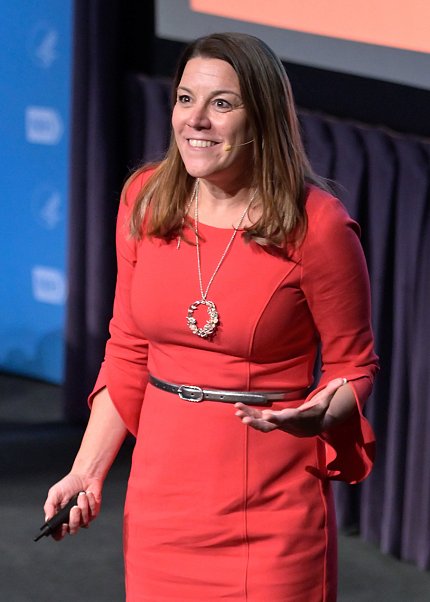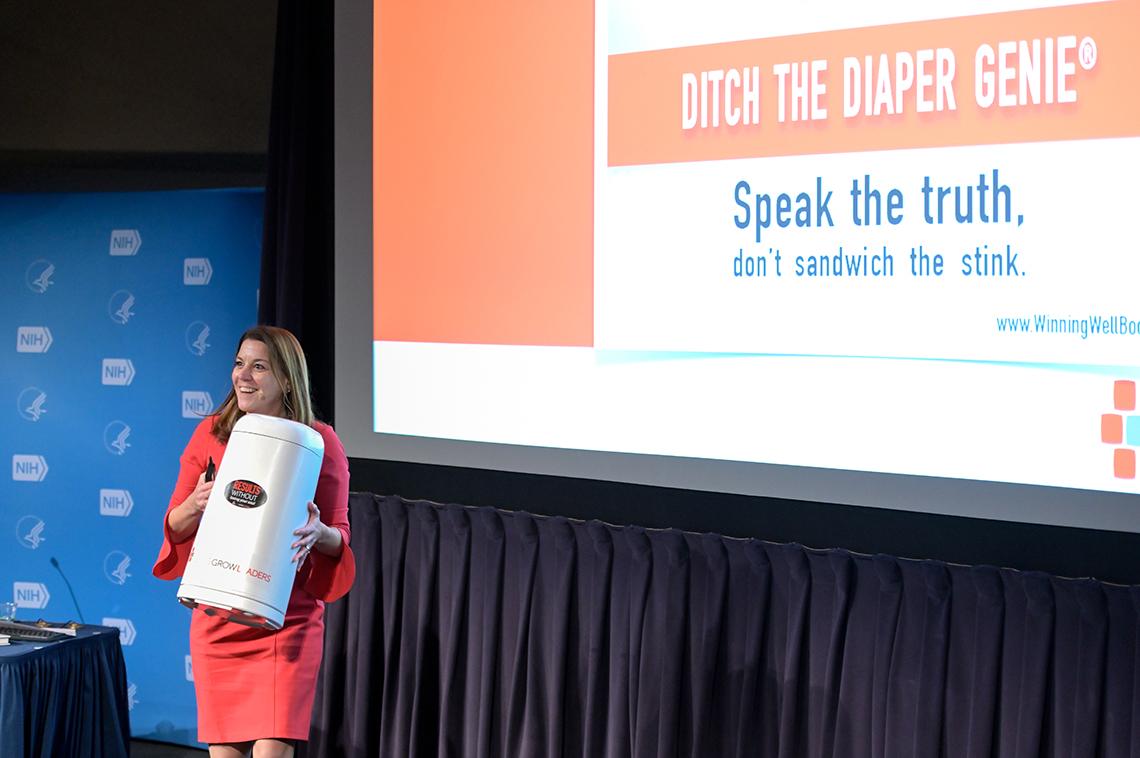Speak Up
Hurt Inspires Us to Build ‘Courageous Cultures’

Photo: Marleen Van Den Neste
It’s a workplace conundrum in organizations big and small, among supervisors and staff of all ages. Managers say they want and ask for good ideas, yet their employees are reluctant to share them.
At a recent Deputy Director for Management Series lecture in Lipsett Amphitheater, leadership expert and author Karin Hurt offered tips on how to address this disconnect by creating “a courageous culture,” an atmosphere where people speak up and readily share ideas.
“We’re not talking about the big ideas that are going to transform science,” said Hurt. “We’re talking about the little ideas that would change processes and make it easier to get things done, that would improve the employee experience without the soul-sucking negative behaviors that make people scared.”
Hurt and her husband David Dye, who together founded the Let’s Grow Leaders consulting firm, collaborated with the University of Northern Colorado’s social research lab to explore the correlation between workplace courage and daily innovation. In interviews with executives and employees across multiple sectors around the world, they overwhelmingly heard the same few answers as to why employees didn’t share their ideas with their supervisors.
Many respondents said nobody asked. More than half said they stopped bothering, discouraged because nothing happened when they proposed ideas—the bulk of which focused on improving efficiency and productivity. Others feared getting in trouble or not being taken seriously; some simply didn’t know how to share their ideas.
But have no fear. Hurt described six strategies to embolden employees and supervisors to create a more courageous culture. First, navigate your narrative. “Be the leader you want your boss to be,” she said.
Hurt learned this lesson after getting promoted to her first executive role. She had asked employees to tap into their personal experiences to inform new policies but failed to share her own story about navigating her new role as a single mom. After an employee challenged her, they revised their plan into an award-winning, culture-changing policy.
“You don’t have to share your personal experience at work,” said Hurt. “But in this instance, I was asking my team to do things I was unwilling to do, and that’s not leadership.”

Photo: Marleen Van Den Neste
The narrative may lead us down unexpected paths. When Hurt once witnessed a pompous outburst from another executive, her boss advised her to ignore it for her career’s sake. Brimming with frustration, Hurt wrote down her ideas about effective leadership and told her colleagues to confront her if she ever inadvertently acted that way. That weekend, she started a leadership blog, which led to speaking engagements and her first of three books.
Hurt has heard many scenarios in workshops she’s conducted over the years. Sometimes the narrative involves a toxic situation, such as harassment, which takes courage to report and expose.
She said, “That’s how you build a culture: one person at a time, one courageous moment at a time, to stand up for what matters, to speak the truth.”
The second strategy toward creating a courageous culture is to forage for fears. Hurt suggested a simple exercise when starting a new project or perhaps going into the new year with a fresh outlook. Give members of your team index cards marked on one side with “H” and on the other side with “F.” Ask each person to jot down their biggest hope and fear and use the submissions to create an honest dialogue.
Next, connect to your cause, perhaps the most effortless strategy at NIH. “I can’t think of a more purpose-driven organization than NIH,” Hurt said.

Photo: Marleen Van Den Neste
“When people are feeling frustrated or disconnected or you’re not getting their best ideas,” she said, “if you can help remind them about the cause, no matter what their role is—connecting what you’re asking them to do to why you’re asking them to do it—that can make them much more inclined to give the extra effort to contribute.”
Hurt and Dye’s research also revealed that the most successful, innovative organizations know how to create clarity and cultivate curiosity.
To solicit or propose great ideas, Hurt suggested considering all criteria within the “IDEA” acronym. Is the suggestion Interesting, Doable, Engaging and what Actions or first steps can put the plan in motion?
“When we talk about clarity, one good conversation about expectations can prevent 14 different ‘why didn’t you?’ conversations,” she said. “[Managers should] be clear about what kinds of ideas would make an impact and [that they’re] open to doing things in a different way.”
A technique she encourages is what she calls ditching the proverbial diaper genie. Diaper pails seal in dirty diapers; although the stench is concealed, it’s still there.
“If you can’t smell it, you can’t solve it,” said Hurt. “In courageous organizations, we have to ditch the diaper genie and talk about the tough things.”

Photo: Marleen Van Den Neste
To cultivate curiosity, ask courageous questions and be open to the answers. Own the “UGLY” of missed opportunities. What are we Underestimating? What’s Gotta go? Where are we Losing or missing the Yes?
Lastly, respond with regard. Let employees be part of the process to test or hone proposed ideas. Create a place where ideas are welcomed and implemented. Then employees feel valued and teams can operate at their fullest potential.
If you’re thinking that courage sometimes feels lonely, “find the others,” advised Hurt, “the people here who want to lead well, who want to build courageous teams, who want to tell the truth. Find your peers, find mentors, because that will help you to build a courageous culture.”
